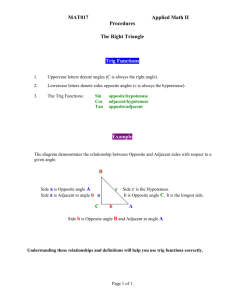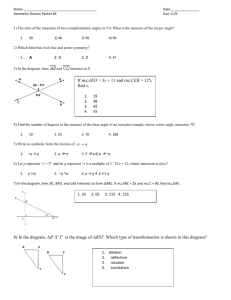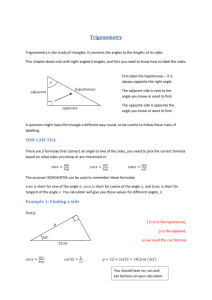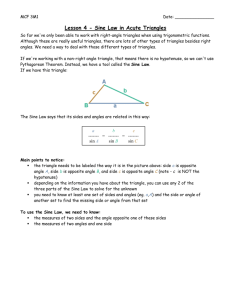Tangent Ratio, Cotangent Ratio, and Inverse Tangent, Sine Ratio
advertisement
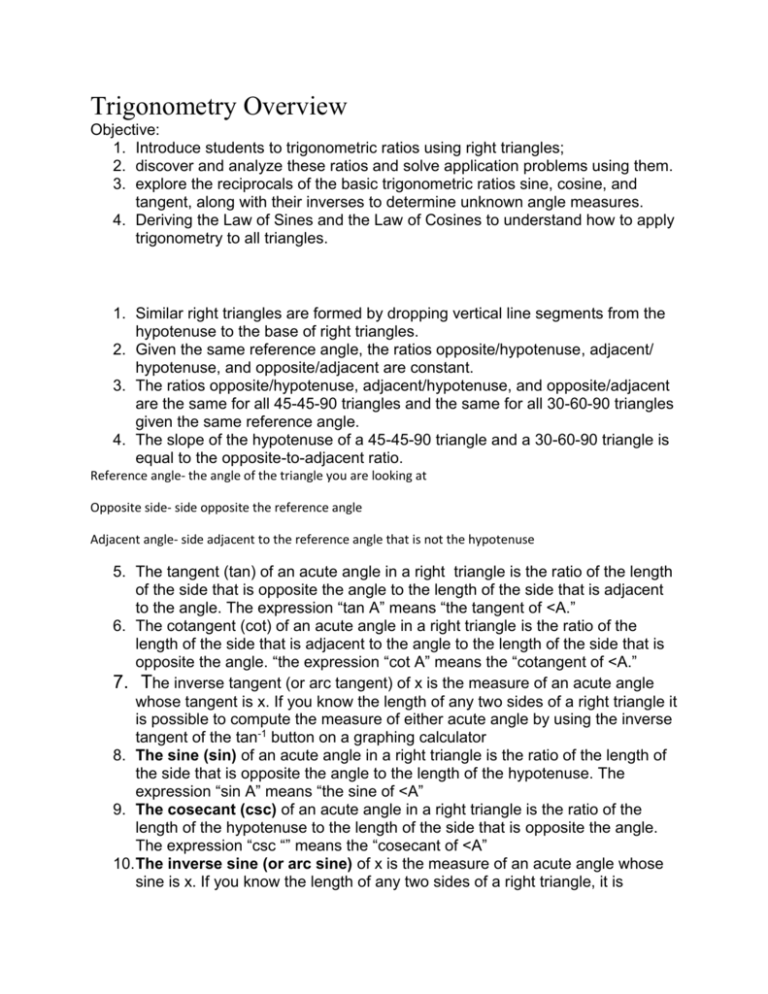
Trigonometry Overview Objective: 1. Introduce students to trigonometric ratios using right triangles; 2. discover and analyze these ratios and solve application problems using them. 3. explore the reciprocals of the basic trigonometric ratios sine, cosine, and tangent, along with their inverses to determine unknown angle measures. 4. Deriving the Law of Sines and the Law of Cosines to understand how to apply trigonometry to all triangles. 1. Similar right triangles are formed by dropping vertical line segments from the hypotenuse to the base of right triangles. 2. Given the same reference angle, the ratios opposite/hypotenuse, adjacent/ hypotenuse, and opposite/adjacent are constant. 3. The ratios opposite/hypotenuse, adjacent/hypotenuse, and opposite/adjacent are the same for all 45-45-90 triangles and the same for all 30-60-90 triangles given the same reference angle. 4. The slope of the hypotenuse of a 45-45-90 triangle and a 30-60-90 triangle is equal to the opposite-to-adjacent ratio. Reference angle- the angle of the triangle you are looking at Opposite side- side opposite the reference angle Adjacent angle- side adjacent to the reference angle that is not the hypotenuse 5. The tangent (tan) of an acute angle in a right triangle is the ratio of the length of the side that is opposite the angle to the length of the side that is adjacent to the angle. The expression “tan A” means “the tangent of <A.” 6. The cotangent (cot) of an acute angle in a right triangle is the ratio of the length of the side that is adjacent to the angle to the length of the side that is opposite the angle. “the expression “cot A” means the “cotangent of <A.” 7. The inverse tangent (or arc tangent) of x is the measure of an acute angle whose tangent is x. If you know the length of any two sides of a right triangle it is possible to compute the measure of either acute angle by using the inverse tangent of the tan-1 button on a graphing calculator 8. The sine (sin) of an acute angle in a right triangle is the ratio of the length of the side that is opposite the angle to the length of the hypotenuse. The expression “sin A” means “the sine of <A” 9. The cosecant (csc) of an acute angle in a right triangle is the ratio of the length of the hypotenuse to the length of the side that is opposite the angle. The expression “csc “” means the “cosecant of <A” 10. The inverse sine (or arc sine) of x is the measure of an acute angle whose sine is x. If you know the length of any two sides of a right triangle, it is possible to calculate the measure of either acute angle by using the inverse sine, or sin-1 button on a graphing calculator. In right triangle ABC, if sin A=x then sin-1x=m<A 11. The cosine (cos) of an acute angle in a right triangle is the ratio of the length of the side that is adjacent to the angle to the length of the hypotenuse. The expression “cos A” means “the cosine of A.” 12. The secant (sec) of an acute angle in a right triangle is the ratio of the length of the hypotenuse to the length of the side that is adjacent to the angle. The expression “sec A” means “the secant of A.” 13. The inverse cosine (or arc cosine) of x is the measure of an acute angle whose cosine is x. If you know the length of any two sides of a right triangle, it is possible to compute the measure of either acute angle by using the inverse cosine, or cos-1 button on a graphing calculator. p. 705 to check, 706 14. When angle A and angle B are acute angles in a right triangle, sin of Angle A= cos angle B and cos of angle A= sin of angle B 15. When angle A and angle B are acute angles in a right triangle, csc of angle A= sec of angle B and sec of angle A= csc of angle B 16. When angle A and angle B are acute angles in a right triangle, tan of angle A= cot of angle B, and cot of angle A= tan of angle B Chapter 9 summary page 729-736



